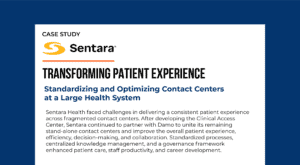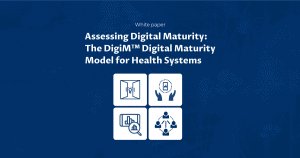Automation and healthcare’s new forcing function for digital transformation
While RPA has proved its success for some administrative functions, other technologies are emerging as options to help address the worker shortage and reduce workload in clinical and operational areas.

Originally published on Healthcare IT News
Every now and then, a “forcing function” comes along that changes the trajectory of a company or an industry. The pandemic may be the most potent forcing function in recent history, and it has transformed healthcare by putting telehealth squarely in the mainstream. Much has been written about how video visits went up by a factor of 30x to 40X from pre-pandemic levels.
The initial effects of the forcing function are wearing off, and Telehealth visits have leveled off somewhat. Questions remain about reimbursement policy, and there is even some concern about the overuse of virtual visits that may exacerbate rather than alleviate the burden on clinicians and increase costs.
That last part may be playing into the narrative of a new forcing function upon us. A recent study by the American College of Healthcare Executives found that the biggest challenge for healthcare CEOs today is the personnel shortage across healthcare. The report highlighted the lack of critical front-line staff that would be essential to ensuring hospitals have workforces that can meet the demands for safe, high-quality care both today and in the future.
Another report, by consulting firm Mercer in late 2021, provides some grim stats on how the shortage of workers will cut across all levels. The shortage will be particularly acute for nurses, mental health, and home health workers.
The reports speak to the need for healthcare organizations to invest in efforts to increase the pipeline of workers, improve retention by developing and supporting staff, and invest in alternate care models. What if conventional talent pipeline development and staff retention policies fail to have the desired effect?
One solution may be harnessing technologies to alleviate the worker shortage, specifically automation.
Automation for the people
All technology is about automation. However, in recent years, we have seen the rise of technologies such as robotic process automation that can effectively replace humans by mimicking repetitive tasks. RPA has successfully reduced human workload in administrative functions such as claim processing and revenue cycle operations.
Several RPA technology companies have succeeded in deploying “digital workers” who can perform repetitive tasks at a fraction of the cost of humans. Five years ago, such a value proposition was disturbing for employers and workers alike. Still, with the reality of worker shortages staring at us, there is a new interest in harnessing RPA to alleviate the lack of workers and potentially redeploy workers from more routine tasks to value-added ones.
While RPA has proved its success in a limited range of administrative functions, other technologies are emerging as viable options for clinical and operational areas that can address the worker shortage and reduce the workload on clinicians.
Voice recognition has gained ground, especially in the past year, thrust to the forefront by the bold acquisition of Nuance by Microsoft and Amazon’s aggressive investments in Alexa skills for home health and senior care.
Conversational interfaces such as chatbots have also come to the forefront, driven by the forcing function of the pandemic, which required a spike in screening for large numbers of individuals with COVID symptoms. It’s fair to say the most prominent use case for chatbots has been COVID-19 screening.
RPA, voice, and chatbots technologies are moving upstream into core healthcare operations by building on the success with initial use cases. At the same time, new technologies are emerging as viable alternatives to reduce human intervention. While yet to make a deep impact on clinical operations, AI technologies are advancing beyond administrative use cases to core operations such as patient engagement and even marketing.
One health system I work with has deployed facial recognition successfully to identify patients during registration and check-in. In the aggregate, a few minutes of savings here and there from the use of technology could add up to a couple of hours in a day for a clinician that can have a substantial impact on the health system.
For health systems to continue to innovate on their care delivery models, expand digital health, and improve organizational efficiencies, the acute shortage of workers is a forcing function like no other today in advancing the adoption of automation technologies.
But what about the shortage of tech workers?
For the first time in my firm’s annual survey of digital transformation priorities and challenges, budgets ranked equally with internal resource constraints as the top challenge for health systems in accelerating digital transformation in 2022. While technology may alleviate the shortage of healthcare workers, at least partly, the shortage of tech workers is itself a challenge that health systems must confront.
As of January 2022, there were 340,000 unfilled IT job openings across all sectors, according to the Wall Street Journal. I see the effects up close in my work with health systems. With remote working options now de rigueur, many tech workers are tired of the long hours and relatively low pay in healthcare and are choosing to take positions in other industries.
Health systems are also losing their talented and long-serving staff to upstart digital health companies flush with VC money, offering the lure of financial gains through stock options.
Not that tech firms have it easy. In the fierce battle for talent, they adopt unusual strategies to remain competitive and grow, including acquiring other firms simply for the talent. Tech firms at the margins are losing their best talent at a fast clip, and some are even shutting down parts of their businesses due to their inability to attract and retain talent.
Health systems must now recognize the magnitude of this 8-point Richter Scale shift in the ground beneath our feet. They must adopt a multi-pronged approach to meet this talent crisis head-on because the traditional methods of pipeline-building, reskilling, and morale-boosting will no longer work.
CIOs have to acknowledge the role of partners in meeting the talent shortage gaps, either by augmenting their internal staff with contracted FTE or outsourcing projects and operations to firms with large talent pools. Maybe even automate IT operations extensively (something many CIOs have already implemented).
Health systems have also been slow to adopt offshore-based workforce models due to data privacy and other concerns. That will need to change (even though the talent shortages in preferred offshore destinations such as India are equally acute).
And yes, all this will require more budgets in the near term.
And no, the technologies are not all that reliable or mature, nor are the workforces in the vendor companies all that stable. Tech firms are susceptible to making poor hires with under-qualified individuals, which puts their product and client implementations at risk. Automation isn’t a 100% replacement for humans. Digital workers like bots need constant care and feeding, just like humans. And the knowledge of how to apply all the technology effectively still resides with humans. CIOs must carefully evaluate their options before making long-term commitments to any technology or vendor.
But then, the status quo is not sustainable. Adopting automation technologies is not an option today – health systems must embrace it cautiously and commit to automation as part of the long-term technology-led transformation towards a digital future. As the wise man said, the definition of insanity is doing the same thing over and over again and expecting a different result.














